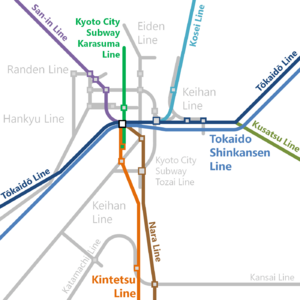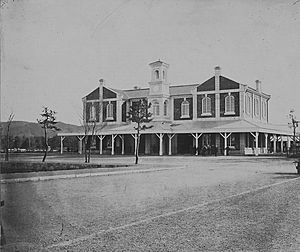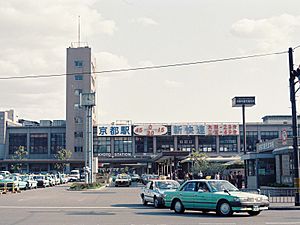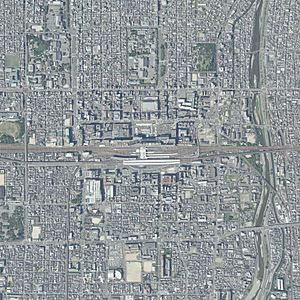Kyōto Station facts for kids
Quick facts for kids
Kyōto Station
京都駅
|
|
|---|---|
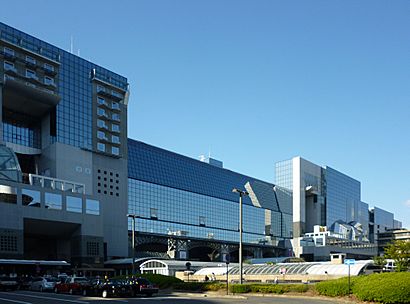
Kyōto Station Building (Karasuma side)
|
|
| Japanese name | |
| Shinjitai | 京都駅 |
| Kyūjitai | 京都驛 |
| Hiragana | きょうとえき |
| General information | |
| Location | Shimogyo-ku, Kyōto City Kyōto Prefecture Japan |
| Operated by | |
| Connections | |
| Other information | |
| Station code | K11, B01 |
| Traffic | |
| Passengers (FY2015) | 255 million |
| Location | |
| Lua error in Module:Location_map at line 420: attempt to index field 'wikibase' (a nil value). | |
Kyōto Station (京都駅, Kyōto-eki) is a very important train station and transport center in Kyōto, Japan. It has the second-largest station building in Japan, after Nagoya Station. It is also one of the biggest buildings in the country!
This huge building has many things inside, like a shopping mall, a hotel, a movie theater, and a big department store called Isetan. It even has some local government offices. All of this is under one roof, which is 15 stories tall! Until 2002, it also had the Kyōto City Air Terminal.
Contents
Train Lines at Kyoto Station
Kyoto Station is a busy place with many train lines. Different companies run these lines:
- JR Central (Japan Railways Central)
- This includes the famous Tōkaidō Shinkansen, which is a super-fast bullet train!
- JR West (Japan Railways West)
- This company runs lines like the Biwako Line, JR Kyoto Line, Sagano Line, and Nara Line.
- Kintetsu
- This is a private railway company that connects Kyoto to other cities.
- Kyoto Municipal Subway
- This is Kyoto's underground train system, with the Karasuma Line stopping here.
Some other train lines also connect to Kyoto Station, like the Kosei Line and Kusatsu Line.
JR West and JR Central Trains
Kyoto Station is a major hub for JR West and JR Central trains. The Shinkansen (bullet train) tracks are raised above the ground. Other train lines, like the Tokaido Line and Sanin Line, are on the ground level.
Many different types of trains stop here, including:
- Limited Express Trains: These are faster trains that make fewer stops. Some popular ones include:
- Thunderbird: Goes to places like Kanazawa.
- Hida: Travels to Takayama.
- Haruka: Connects Kyoto to Kansai Airport.
- Kuroshio: Goes to Shirahama and Shingu.
- Super Hakuto: Travels to Tottori and Kurayoshi.
- Kinosaki, Hashidate, and Maizuru: These go to different parts of the Sanin region.
Kintetsu Trains
The Kintetsu part of Kyoto Station has three levels. The second floor is where you'll find the train platforms. The first floor is a shopping street, and the third floor is actually where the Shinkansen platforms are located!
Kintetsu trains here include:
- Limited Express Trains: These trains go to popular destinations like Nara, Kashiharajingu-mae, and Kashikojima.
- Local and Express Trains: These trains make more stops and connect to places like Tambabashi, Shin-Tanabe, and Yamato-Saidaiji.
Kyoto City Subway
The Kyoto City Subway station is underground. It has one main platform with two tracks. The subway's Karasuma Line connects Kyoto Station to many parts of the city. You can take it to places like Takeda, Shijō, and Kokusaikaikan.
History of Kyoto Station
The first Kyoto Station opened a very long time ago, on February 5, 1877. It was built after the railway from Kobe reached Kyoto.
Over the years, the station grew. In 1889, it became part of the main train line connecting to Tokyo. Later, other private railways also connected to Kyoto Station, linking it to different parts of Kyoto Prefecture.
The station building was rebuilt several times:
- In 1914, a new, fancy station opened. It had a big square in front, which was sometimes used by the Emperor's motorcades. Sadly, in 1934, a crowd gathered there to say goodbye to naval recruits, and 77 people were hurt in a crush.
- This station burned down in 1950. A more simple concrete building replaced it in 1952.
- The current Kyoto Station opened in 1997. This was to celebrate Kyoto's 1,200th anniversary! It's a very modern building, 70 meters tall and 470 meters wide. It looks futuristic with its glass and steel design. The architect was Hiroshi Hara.
When this new station was built, some people in Kyoto were worried because the city is known for its old cultural sites. But the station's completion led to more new, tall buildings being built in the city.
The south side of the station, called the Hachijō-guchi building, was built for the Shinkansen (bullet train) when it started running in 1964. The underground shopping mall, Porta, was built when the subway opened in 1981.
In March 2018, JR Lines started using station numbers to make it easier for people to find their way. Kyoto Station got numbers like JR-A31, JR-B31, JR-E01, and JR-D01.
How Many People Use Kyoto Station?
Kyoto Station is very busy! In 2016, about 200,426 passengers used the JR West part of the station every day. This made it the second busiest JR West station after Osaka Station. The Kyoto City Subway station was used by about 123,360 passengers daily in the same year.
What's Around Kyoto Station?
Kyoto Station is surrounded by many interesting places and buildings. It has different exits, like the Karasuma Gate and the Hachijo Gate.
Karasuma Gate
This is the north side of the station. Here you can find:
- The main Kyoto Station Building, with the JR Kyoto Isetan department store, "The Cube" shopping street, Hotel Granvia Kyoto, and Kyoto Gekijo (a theater).
- The Kyoto Station Underground Mall "Porta".
- Kyoto-Yodobashi (a large electronics store).
- Kyoto Tower, a famous landmark.
- Higashi Hongan-ji, a large Buddhist temple.
- The Kyoto Central Post Office.
Hachijo Gate
This is the south side of the station. Here you can find:
- Hotel Kintetsu Kyoto Station.
- Kyoto Avanti, another shopping center.
- Bus terminals for sightseeing and highway buses.
- New Miyako Hotel.
- To-ji, a historic temple with a famous pagoda.
- ÆON Mall Kyoto, a large shopping mall.
Bus Terminals
Kyoto Station is also a major hub for buses, including highway buses that travel to other cities across Japan. There are bus stops at both the Karasuma Gate and the Hachijo Gate.
Highway Buses
Many highway buses leave from Kyoto Station, connecting it to cities like:
- Tokyo, Shinjuku, Yokohama
- Nagoya, Shizuoka
- Fukui, Kanazawa, Toyama
- Osaka, Hiroshima, Okayama
- Nara, Wakayama
- Kansai International Airport and Osaka International Airport
These buses offer a way to travel long distances comfortably.
Images for kids
See also
 In Spanish: Estación de Kioto para niños
In Spanish: Estación de Kioto para niños
- List of railway stations in Japan


